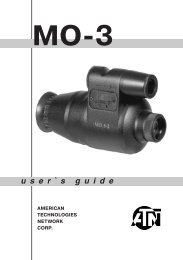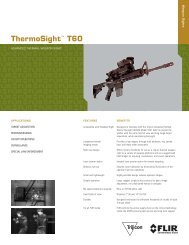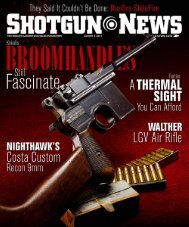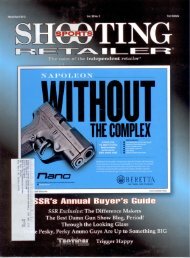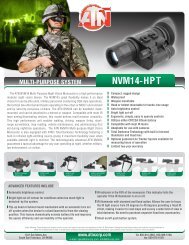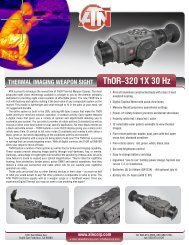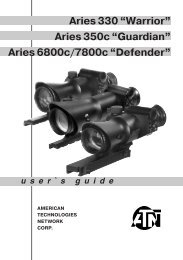ATN MK 410-B Spartan - ATN night vision
ATN MK 410-B Spartan - ATN night vision
ATN MK 410-B Spartan - ATN night vision
Create successful ePaper yourself
Turn your PDF publications into a flip-book with our unique Google optimized e-Paper software.
Illuminated reticles<br />
are most useful<br />
on dark, big-game<br />
animals, such as<br />
this truly black,<br />
black bear, taken in<br />
Alaska.
Bushnell offers a phosphorenhanced,<br />
plex-type reticle called the<br />
Firefly on some of its Elite 3200 scopes.<br />
When the Firefly is "charged" with a<br />
flashlight, the edges of the reticle glow<br />
for at least a couple of hours; and,<br />
since the reticle itself is pretty heavy, it<br />
works very well for dim-light aiming.<br />
My wife Eileen used a 3-9X 3200 with<br />
the Firefly on a last-light black bear a<br />
few years ago, and the reticle helped a<br />
lot. .<br />
Actually<br />
also come<br />
black black bears (they<br />
in colors from blond to<br />
brown, even brick-red) are one of the<br />
toughest targets for a conventional<br />
reticle, because the center of the<br />
reticle is often lost against the bear,<br />
especially in dim light. The same thing<br />
happens with dark pigs, the reason<br />
many European scopes come with<br />
electronically illuminated reticles.<br />
Illuminated reticles have recently<br />
become more popular in North<br />
America, both for'pigs and quasi-<strong>night</strong><br />
whitetail shooting, but some of the<br />
first electronic reticles in "American"<br />
scopes didn't have any means of finely<br />
controlling the intensity of the lighted<br />
aiming point. These days almost all<br />
are almost infinitely adjustable for<br />
brightness, helping enormously as light<br />
conditions change. A really-brightly-lit<br />
aiming point is handy in typical forest<br />
cover, especially on a cloudy day, but<br />
the same intensity overwhelms the<br />
sight picture when aiming in neardarkness.<br />
Many of the early scopes also had<br />
problems with battery life, partly<br />
because the intensity couldn't be<br />
controlled. Better batteries have helped<br />
enormously, and many newer scopes'<br />
also shut off automatically after<br />
several hours. I recently used a Zeiss<br />
Victory Diavari 2.5-IOX on a pig hunt<br />
in Texas and left the reticle turned on<br />
much of the time for three days, and<br />
still didn't come close to using up the<br />
battery. I've also used several other<br />
electronic reticle scopes, mostly for pig<br />
hunting. They help enormously in any<br />
really dim light, but can even help in<br />
dim woods, where a fine point can help<br />
when trying to precisely put a bullet<br />
between twigs.<br />
A few brands offer an entirely<br />
illuminated reticle. For a while I<br />
owned a 5.5-22X Nightforce with a<br />
multi-point reticle that lit up like a<br />
burning bush. These reticles obviously<br />
require more battery power, and also<br />
really aren't all that useful in hunting,<br />
since it's rare to shoot at an animal at<br />
ranges where an illuminated "ballistic"<br />
reticle might be useful. You just can't<br />
see animals that far away at <strong>night</strong>, even<br />
in a very big, bright scope.<br />
When shooting in real darkness,<br />
however, a true <strong>night</strong>-<strong>vision</strong> scope<br />
beats any illuminated-reticle scope.<br />
They're only legal in a few places, but<br />
when <strong>night</strong>-<strong>vision</strong> can be used it makes<br />
a real difference.<br />
The <strong>night</strong>-<strong>vision</strong> optics available<br />
to the civilian market are normally<br />
described as Generation 1, 2 or 3<br />
or more popularly as Gen 1, 2 or 3.<br />
The numbers indicate a rough level of<br />
performance and cost. A typical Gen<br />
1 scope enhances the available light<br />
. about 1,000 times, Gen 2 about 20,000<br />
times and Gen 3 up to 50,000 times.<br />
(There are <strong>night</strong>-<strong>vision</strong> optics beyond<br />
Gen 3, but right now they're almost<br />
entirely military.)<br />
The differences in view aren't just<br />
in brightness, but sharpness. A Gen<br />
1 scope, like the <strong>ATN</strong> <strong>MK</strong> <strong>410</strong> 5X<br />
<strong>Spartan</strong> I've been testing for a while,<br />
definitely allows shooting in much<br />
dimmer light than any conventional<br />
scope. One of my first tests was on<br />
a starlit <strong>night</strong>, with a cardboard pig<br />
silhouette placed 100 yards out in a<br />
field. It was impossible to aim at this pig<br />
with even the brightest conventional<br />
scopes in my collection, including<br />
$1,000+ models from Leica, Leupold,<br />
Schmidt & Bender, Swarovski and<br />
Zeiss. But with the $600 <strong>Spartan</strong> the<br />
fake pig could not only be seen, but<br />
also shot accurately.<br />
I don't <strong>night</strong>-hunt enough to justify<br />
buying something like the $4,000-plus<br />
Night Optics USA D-740-3AG 4x82<br />
scope that Bill Wilson has on one of his<br />
AR-15s for hunting pigs on his Texas<br />
ranch. But Bill is Wilson Combat, and<br />
justifies the cost both because of the<br />
research he has to keep up with trends<br />
in combat firearms, and because he<br />
loves to hunt pigs.<br />
I spent a few days with Bill in the<br />
winter of 2010, "field-testing" some of<br />
hiS' ARs in 6.8 SPC not only on pigs,<br />
but one coyote. The hunting took place<br />
at all times of the day, from stands and<br />
on the ground. On the second evening<br />
Bill picked me up from a stand an hour<br />
or so after sunset, and asked if I'd like<br />
to do some "real <strong>night</strong> hunting."<br />
"Sure," 1said, assuming that meant<br />
spotlighting. Instead it meant real<br />
<strong>night</strong> <strong>vision</strong>.<br />
We drove to a wide valley along a<br />
tributary of the Sulphur River, then<br />
got out and started toward the creek.
The sky was partly cloudy but enough<br />
stars peeked out to allow us to walk<br />
without tripping. Bill also had along<br />
his Night Optics binocular, and a<br />
few hundred yards from the truck we<br />
stopped while he scanned the cattle<br />
pastures that sloped gently down<br />
toward the creek. "There are some<br />
cows," he whispered, "and some deer."<br />
Then he suddenly stopped scanning.<br />
"And there are some pigs."<br />
He handed me the binocular and<br />
the view was astonishing. I've been<br />
around <strong>night</strong> optics since the first<br />
crude monoculars. went on the market<br />
in the I990s. The first ones weren't<br />
quite capable of differentiating a deer<br />
and a benchrest at 100 yards, but<br />
through Bill's binocular w~ could tell<br />
the difference between cows and pigs<br />
at half a mile or more.<br />
A light breeze came from the wrong<br />
direction for a direct stalk, so we made<br />
a big circle, eventually moving very<br />
slowly and silently up a slight rise to<br />
where we'd seen the pigs. As we crested<br />
the rise Bill stopped frequently to scan<br />
the ground ahead, then leaned close<br />
and whispered, "There they are." I set<br />
up the AR-15 on a pair of shooting<br />
sticks and pressed my right eyebrow<br />
into the collapsible-rubber eyepiece of<br />
the scope, activating the <strong>night</strong> <strong>vision</strong>.<br />
About 100 yards away a blackand-white<br />
boar fed on the lush grass,<br />
so precisely visible that I could not<br />
only see his spots, but his ears. He was<br />
angling away, not providing any S9rt<br />
of broadside shot, so-r- aimed under<br />
the near ear and pulled the trigger.<br />
The suppressed rifle made a little<br />
whonk and clatter, and the other pigs<br />
in the vicinity immediately ran into the<br />
nearby brush, but the boar dropped<br />
straight down and never moved again.<br />
Night-<strong>vision</strong> scopes may not be legal<br />
for German boars, but they sure work<br />
in Texas. G!13<br />
<strong>ATN</strong> CORP.<br />
1341 SAN MATEO AVE.<br />
SOUTH SAN FRANCISCO, CA 94080<br />
(800) 910-2862<br />
WWW.GUNSMAGAZINE.COM/<strong>ATN</strong><br />
BUSHNELL CORPORATION<br />
9200 CODY, OVERLAND PARK, KS 66214<br />
(800) 423-3537<br />
WWW.GUNSMAGAZINE.COM/BUSHNELL<br />
NIGHT OPTICS USA, INC.<br />
15182 TRITON LN., SUITE 101<br />
HUNTINGTON BEACH, CA 92649<br />
(800) 306-4448<br />
WWW.GUNSMAGAZINE.COM/N IGHT-OPTI CS<br />
Nefarious scoundrels have been trying<br />
to SCAM Ham/gunner readers by offering<br />
UNAUTHORIZEDsubscriptions for a ridiculously<br />
HIGHprice. Don't be a victim of this<br />
dastardly behavior! It's easy to protect<br />
yourself; simply remember: NEVER pay<br />
more than $36 for a two year subscription<br />
to Handgunner! If it says $71, toss it! I've<br />
received a bunch of calls from you guys<br />
reporting suspicious offers to renew your<br />
subs to Handgunner. You have reported<br />
getting offers on mailing pieces looking<br />
SUSPICIOUSLYsimilar to ours. They direct<br />
you to write a check or submit a credit card<br />
number for the OUTRAGEOUSprice of $71<br />
(that's almost twice the published price!!!).<br />
They APPEAR to be from us - but they<br />
are most certainly NOT!While it's still rare,<br />
it has occurred, so keep a SHARP eye and<br />
don't be shy about questioning something<br />
like this.<br />
It's EASYto make sure it's legit. Confirm<br />
the Handgunner ID NUMBERon the top line<br />
of the renewal label matches your ID on<br />
the magazine you get. The price is never<br />
higher than $19.75 for one year, or $36.75<br />
for two. Our"offers say "Make check payable<br />
to American Handgunner (NOT SOME<br />
SLEAZYTHIRDPARTY!).The return address<br />
will be either 12345 World Trade Dr. San<br />
Diego, or PO Box 509093 in San Diego <br />
ANYTHINGELSESPELLSTROUBLE!<br />
Keep in mind, we're a phone call away.<br />
Pick up, the phone and dial (858) 605-0253<br />
to chat with one of our ace subscription<br />
ladies or go to www.americanhondgunner.<br />
com and click on "Contacts" to reach us.<br />
We're all actual human beings and will be<br />
happy to help YOU out anytime. You can always<br />
drop me a note at editor@omericanhand<br />
gunner. com if you think I can help out,<br />
want to report a scam or have a question.<br />
-- Roy Huntington, Editor<br />
~ ..,.<br />
RETICLE 44<br />
ILLUMINATED<br />
Most hunting reticles light up in the center,<br />
rather than illuminating the entire reticle.<br />
TRIJICON<br />
49835 SHAFER AVE.<br />
P.O. BOX 930059<br />
WIXOM, MI 48393<br />
(800) 338-0563<br />
WWW.GUNSMAGAZINE.COMITR<br />
CARL ZEISS, INC.<br />
13005 N. KINGSTON AVE.<br />
CHESTER, VA 23836<br />
(800) 441-3005<br />
WWW.GUNSMAGAZINE.COMIZE<br />
IJ ICON<br />
ISS<br />
61




